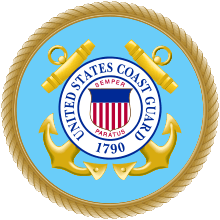List of equipment of the United States Coast Guard
The United States Coast Guard uses cutters and small boats on the water, and fixed- and rotary wing (helicopters) aircraft in the air. The Coast Guard employs various small arms including handguns, shotguns, rifles, and machine guns.

Watercraft
Cutters
Originally, the Coast Guard used the term cutter in its traditional sense, as a type of small sailing ship. Today it officially uses the term for any vessel which has a permanently assigned crew and accommodations for the extended support of that crew, and includes only and all vessels of 65-foot (20 m) or more in length.[1]
Larger cutters (over 181 feet (55 m) in length) are controlled by Area Commands (Atlantic Area or Pacific Area). Smaller cutters come under control of district commands. Cutters usually carry a motor surf boat and/or a rigid-hulled inflatable boat. Polar-class icebreakers (WAGB) carry an Arctic survey boat (ASB) and landing craft.
The Coast Guard formerly leased 179-foot Cyclone-class coastal patrol ships from the U.S. Navy. All are homeported in Pascagoula, Mississippi. These vessels were used primarily for counterdrug patrols.[2][3][4] Four have now been returned to the navy.
Any Coast Guard crew with officers or petty officers assigned has law-enforcement authority (14 USC Sec. 89) and can conduct armed boardings.
.jpg)
- For a complete list of cutters see: United States Coast Guard Cutter and List of United States Coast Guard cutters
- Polar Security Cutter: The Polar Security Cutter Program is the program to replace the United States Coast Guard's aging fleet of icebreakers.
- Polar-class icebreaker (WAGB): There are three WAGB's, all home ported in Seattle, Washington. Two are 399-foot (122 m) icebreakers (Polar Sea and Polar Star), and one newer 420-foot (130 m) icebreaker, Healy.
- National Security Cutter (WMSL) (aka Legend-class)[5]
- High Endurance Cutter (WHEC): These are 12 Hamilton class cutters, 378 feet (115 m) along the waterline. Only 2 still in use, with 9 having been transferred to the Philippines, Bangladesh, Vietnam, and Nigeria.
- USCGC Mackinaw (WLBB-30): Mackinaw is a 240-foot (73 m) heavy icebreaker built for operations on the North American Great Lakes and home ported at Cheboygan, Michigan.
- USCGC Eagle (WIX-327): Eagle is home ported at the Coast Guard Academy in New London, Connecticut. It is used for training voyages for Coast Guard Academy cadets and Coast Guard officer candidates. USCGC Eagle was built in Germany as the Horst Wessel, and was taken by the United States as a war reparation in 1945.
- Heritage-class Offshore Patrol Cutter (Still in development)
- Medium Endurance Cutter (WMEC): These include fourteen 210-foot (64 m) Reliance-class cutters, thirteen 270-foot (82 m) Famous-class cutters, and the 282-foot (86 m) Alex Haley.
- 179-foot Cyclone-class coastal patrol ships: All ships formerly operated by the USCG were transferred back to the navy along with one transferred to the Philippine Navy.[6]
- Seagoing Buoy Tender (WLB): There are 16 Juniper-class buoy tenders being commissioned.
- USCG coastal buoy tender
- USCG Katmai Bay class icebreaking tug
- 156-foot Sentinel-class Fast Response Cutter
- 110-foot Island Class Cutter (WPB): There are currently 41 110′ patrol boats in active duty service in the U.S. Coast Guard. Eight additional 110-foot patrol boats were extended to 123 feet (37 m) but structural issues developed shortly after these conversions and the cutters were deemed unsafe to operate. The Coast Guard as of 2007 the USCG was seeking a $50 million refund from Bollinger Shipyards. Six of the WPB fleet are assigned to the Patrol Forces Southwest Asia (PATFORSWA) in the Persian Gulf to assist guarding Iraq's waters.[7]
- 87-foot Marine Protector Class Cutter (WPB): This is a class of 87-foot (27 m) patrol boats.
- 65-foot Small Harbor Tug (WYTL): This is a class of fifteen tugs used by the United States Coast Guard for search and rescue, law enforcement, aids-to-navigation work and light icebreaking.
Boats

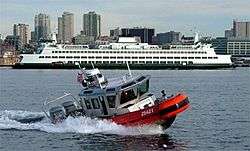
The Coast Guard operates about 1,402 boats, defined as any vessel less than 65 feet (20 meters) in length, which generally operate near shore and on inland waterways. The most common is 25 feet (7.62 m) long, of which the Guard has more than 350;[8] the shortest is 12 feet (4 m).
The Coast Guard boat fleet includes:
- Arctic Survey Boat (ASB)
- 52-foot Motor Life Boat (MLB): The Coast Guard currently has four of the 52-foot motor life boats, a craft designed from the ground up to serve in challenging surf conditions. All four craft are currently assigned to surf stations in the Pacific Northwest.
- 47-foot Motor Life Boat (MLB): The Coast Guard's primary heavy-weather boat used for search and rescue as well as law enforcement and homeland security.[9]
- Aids to Navigation Boats (TANB/BUSL/ANB/ANB)
- Transportable Port Security Boat (TPSB): 25-foot (7.6 m) boat, based on the commercial version of the 25-foot (8 m) center-console Boston Whaler, suitable for work in inland waters, easily transportable by trailer. These are primarily used by Port Security Units for force protection in naval support areas abroad, as well as, ports of embarkation/debarkation in expeditionary areas. Most recently these boats and units were deployed to Kuwait in support of Operation Iraqi Freedom. The durability, versatility, and mobility of these boats make them ideal for this type of operation.[10]
- The Coast Guard planned to reduce the inventory of Boston Whalers because of the lack of interoperable spare parts. On Friday, July 13th, the General Services Administration approved the transfer of 10 Coast Guard boats to the Army in Iraq. The boats, 24-foot and 27-foot Boston Whalers with trailers, had an original acquisition cost of more than $800,000. The Army is looking for approximately 55 Riverine or Patrol style boats to conduct water interdiction, river denial and island clearance missions, troop transport and insertion on a regular basis; the Coast Guard is providing the Army with the Boston Whalers and one Ambar boat, a patrol type vessel.[11]
- 32 ft Transportable Port Security Boat (TPSB): A 32-foot boat designed to replace the 25 foot TPSB boat with various improvements in crew safety, protection, and comfort.[12]
- USCG Short Range Prosecutor (SRP): A 7-meter (23 ft) launch that could be launched from a rear launching ramp, at speed. The SRP was removed from service due to multiple problems with its systems. It has been replaced by the over the horizon boat Mark IV (OTH-IV)
- USCG Long Range Interceptor (LRI): An 11-meter (36 ft) high-speed launch that can be launched from the rear ramps of the National Security Cutters.[13]
- Response Boat-Small (Defender-Class): A high-speed boat, for a variety of missions, including search and rescue, port security and law enforcement duties. The original 25-foot boats built by SAFE Boats International (Secure All-around Flotation Equipped) of Port Orchard, Washington are being replaced by 29-foot boats built by Metal Shark Boats of Jeanerette, LA.[14][15]
- Response boat - Small II: A 29 foot replacement for the Defender Class, built by Metal Shark Boats

- 45-Foot Response Boat – Medium: The Coast Guard has signed a multi-year contract for 180 Response Boat – Medium (RB-M) boats that were delivered starting in 2008 to replace the 41′ UTB boats. These aluminum boats are 45 feet (13.7 m) in length, have twin diesel engines (total 1650 hp), are self-righting, have a four crew, six passenger capacity, are equippable with two .50 caliber machine guns, have an excellent fendering system, have a top speed of 42 knots (78 km/h), and are capable of towing a 100-ton vessel in eight-foot seas. The boats were built by Kvichak Marine Industries of Kent, Washington and Marinette Marine of Manitowoc, Wisconsin.[16][17]
- There are a number of Special Purpose Crafts (SPC), as follows:[18] 18', 20' and 22' Airboats (SPC-AIR & SPC-Airboat),[19] 36' Boarding Team Delivery (SPC-BTD), 52' Heavy Weather (SPC-HWX), 33' Law Enforcement (SPC-LE),[20] 42' Near Shore Lifeboat (SPC-NSB), 24' Shallow Water (SPC-SW),[21]
64' Screening Vessel (SPC-SV), 38' Training Boat (SPC-TB),[22] 39' Tactical Training Boat (SPC-TTR)
- USCG Auxiliary Operational Facilities: The Coast Guard surface fleet is augmented by privately owned vessels operated by the United States Coast Guard Auxiliary.
Aircraft

The Coast Guard operates about 210 aircraft. Fixed-wing aircraft (such as Lockheed HC-130 Hercules turboprops) operate from Air Stations on long-duration missions. Helicopters (Aérospatiale HH-65 Dolphin, Sikorsky HH-60J Jayhawk, and Agusta MH-68 Stingray) operate from Air Stations, Air Facilities, and flight-deck equipped cutters, and can rescue people or intercept smuggling vessels. Some special MH- designated helicopters are armed with guns and some are equipped with armor to protect against small arms fire.
The Coast Guard flies several aircraft types:
- 27 Lockheed HC-130 Hercules
- 42 Sikorsky MH-60T Jayhawk[23]
- 102 Airbus MH-65 Dolphin
- 11 HC-27J Spartan[24][25] Out of 14 on order.
- 18 CASA HC-144A Ocean Sentry.[26][27][28]
- 2 Gulfstream C-37A aircraft as a VIP transport for high-ranking Coast Guard and Homeland Security officials.[29]
- An unspecified number of RG-8A Condors.
The Coast Guard was to purchase the Bell Eagle Eye UAV as part of the Deepwater program, but this has been cancelled.[30] The Coast Guard is currently preparing to launch a small UAS competition for the Legend-class NSC and future Heritage-class cutter.[31]
In addition to regular Coast Guard aircraft, privately owned general aviation aircraft are used by Coast Guard Auxiliarists for patrols and search-and-rescue missions.

Land vehicles
| Name | Image | Origin | Quantity | Notes |
|---|---|---|---|---|
| MWV | ||||
| HMMWV |  |
limited unspecified number | [32] | |
| LSSV |  |
unspecified number | ||
Small arms
| Model | Image | Caliber | Type | Origin | Details | |
|---|---|---|---|---|---|---|
| Pistols | ||||||
| M9 | 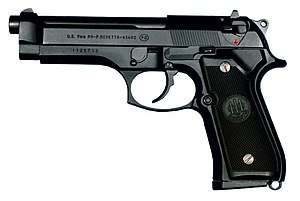 | 9mm | Pistol | Limited service | ||
| P229R-DAK | .jpg) | .40 S&W | Pistol | Standard service pistol | ||
| Assault Rifles | ||||||
| M16A2 | 5.56×45mm NATO | Assault rifle | Limited service | |||
| M4 |  | 5.56×45mm NATO | Carbine | Standard issue service rifle. The Deployable Operations Group also employs the Mk 18 upper receiver[33] | ||
| Mk 18 carbine | 5.56×45mm NATO | Carbine | Standard issue service carbine. The Maritime Security Response Team also employs them | |||
| Shotguns | ||||||
| M870P | _91106.jpg) | 12-gauge | Shotgun | |||
| Machine Guns | ||||||
| M240 |  | 7.62×51mm NATO | General purpose machine gun | M240B variant is employed aboard surface vessels while the M240H is used aboard the MH-60 Jayhawk and MH-65 Dolphin helicopters. The M240 is also used on land by Port Security units[34] | ||
| M60 |  | 7.62×51mm NATO | General purpose machine gun | Used on various boats such as the Defender-class boat[35] | ||
| Browning M2HB |  | .50 BMG | Heavy machine gun | Primarily mounted on seagoing vessels. Some machine guns are used on land by Port Security Units[36] | ||
| Precision Rifles | ||||||
| M14 |  | 7.62×51mm NATO | Designated marksman rifle | Variant known as the M14 Tactical fitted with the Mk 14 Enhanced Battle Rifle stock, with a 22-inch barrel and a Smith Enterprise muzzle brake. | ||
| Mk 11 | 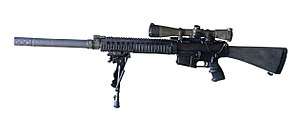 | 7.62×51mm NATO | Sniper rifle | Used by the Deployable Operations Group[33] | ||
| M107 |  | .50 BMG | Anti-materiel rifle, sniper rifle | Used for Airborne Use of Force (AUF) missions | ||
| Grenade-Based Weapons | ||||||
| M203 | 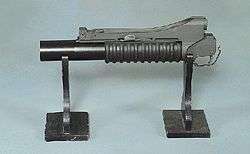 | 40mm | Grenade launcher | Single-shot underbarrel grenade launcher[37] | ||
| Mk 19 | 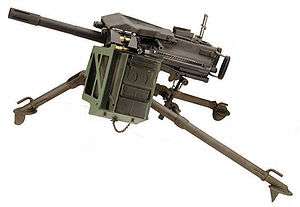 | 40mm | Automatic grenade launcher | Belt-fed | ||
| MK3 grenade |  | Concussion Grenade | Used as an anti-swimmer grenade. Being phased out and being replaced by a newer Anti-Swimmer Grenade.[38] | |||
Communications
Coast Guard radio stations cover a wide geographical area using very high frequency and high frequency radios. There are eight major radio stations covering long-range transmissions and an extensive network of VHF radio stations along the nation's coastline and inland rivers.
The current communication system is the Rescue 21. Rescue 21 is an advanced maritime command, control, and communications (C3) system.
The OMEGA navigation system and the LORAN-C transmitters outside the USA were run until 1994 also by the United States Coast Guard, and LORAN-C transmitters within the US were decommissioned on June 1, 2010, with the exception of 5 CONUS LORAN-C stations that continue to be manned due to international agreements.
See also
- Equipment of the United States Army
- Equipment of the United States Air Force
- Equipment of the United States Navy
- Equipment of the United States Marine Corps
References
| Wikimedia Commons has media related to United States Coast Guard equipment. |
- USCG Regulations Archived 2006-07-23 at the Wayback Machine. Chapter 10. Accessed 11 December 2006.
- PA3 Brian Leshak, "CG Leases Navy Ships, Fights Drug War". Coast Guard Magazine 2/2006, pp. 32–33.
- "WPC Fact Sheet". Archived from the original on 2010-08-02. Retrieved 2010-06-15.
- "Naval Vessel Register". Archived from the original on 2016-06-19. Retrieved 2016-06-28.
- "Northrop Grumman to Supply Polar Ice Breaker Navigation Support for U.S. Coast Guard". October 20, 2013. Archived from the original on October 21, 2013. Retrieved October 21, 2013.
- "PATROL COASTAL SHIPS - PC". Archived from the original on 7 December 2017. Retrieved 6 December 2017.
- "Our Opinion: Shipbuilding issues should be solved". The Mississippi Press. July 23, 2007. Archived from the original on January 24, 2013. Retrieved 2007-07-23.
- "Operational Assets". U.S. Coast Guard}. Archived from the original on 28 February 2018. Retrieved 8 August 2018.
- U.S. General Service Administration. "Boats Transferred to Iraq Archived 2011-10-01 at the Wayback Machine". Accessed 4 September 2007.
- "Enhancing our ability to protect, defend the maritime domain". coastguard.dodlive.mil. Archived from the original on 2 May 2017. Retrieved 28 June 2017.
- "Archived copy". Archived from the original on 2013-09-27. Retrieved 2013-09-24.CS1 maint: archived copy as title (link)
- "Keel Laying Ceremony Marks Production of New Response Boat" (Press release). United States Coast Guard. 2007-06-28. Archived from the original on 2007-10-11.
- "Archived copy". Archived from the original on 2009-10-15. Retrieved 2009-10-15.CS1 maint: archived copy as title (link)
- USDHS, USCG, Boat Management Manual: COMDTINST M16114.4B
- "Metal Shark 24 Relentless (SPC-SW)". Metal Shark Aluminum Boats. Archived from the original on 2013-09-27. Retrieved 2013-09-24.
- "Metal Shark 38 Defiant". Metal Shark Aluminum Boats. Archived from the original on 2013-09-27. Retrieved 2013-09-24.
- HH-60J Jayhawk Archived 2013-04-01 at the Wayback Machine at GlobalSecurity.org
- "USCG receives 11th regenerated C-27J". Naval Warfare International. 20 February 2017. Archived from the original on 27 February 2017. Retrieved 26 February 2017.
- "Archived copy". Archived from the original on 2017-02-27. Retrieved 2017-02-26.CS1 maint: archived copy as title (link)
- Air Forces Monthly. Stamford, Lincolnshire: Key Publishing Ltd. March 2013. p. 31.
- "EADS North America Delivers 15th HC-144A Ocean Sentry to U.S. Coast Guard". June 7, 2013. Archived from the original on June 14, 2013. Retrieved June 9, 2013.
- "Airbus Group, Inc. delivers U.S. Coast Guard with its 16th HC-144A Ocean Sentry Aircraft". January 22, 2014. Archived from the original on February 1, 2014. Retrieved January 23, 2014.
- "Bell Eagle Eye HV-911". USCG. Archived from the original on 2006-08-30. Retrieved 2006-08-25.
- "US Coast Guard to Launch sUAS Competition". www.uasvision.com. Archived from the original on 25 January 2018. Retrieved 24 January 2018.
- name="IHS Jane's Land Warfare Platforms Logistics, Support & Unmanned 2015-2016 AM
- Joint Service Small Arms Systems Annual Symposium - 20 May 2008
- "Port Security Unit 305 provides anti-terrorism force protection in Guantanamo Bay, Cuba". coastguard.dodlive.mil. Archived from the original on 26 August 2017. Retrieved 26 August 2017.
- http://arquivo.pt/wayback/20091015144424/http://www.uscg.mil/acquisition/programs/pdf/rb-sfactsheet.pdf U.S. Coast Guard: Response boat-small fact sheet(PDF)
- "Everyday heroes tasked with extraordinary duties". www.flickr.com. Retrieved 26 August 2017.
- PA2 John Edwards and PA1 Kimberly Smith, PADET Atlantic City. "Learning to Shoot All Over Again". Coast Guard Magazine, Issue 2, 2006, pp. 4–19.
- "Anti-Swimmer Grenade offers underwater port security". www.navair.navy.mil. Navair.navy.mil. Retrieved 28 January 2017.
.jpg)
